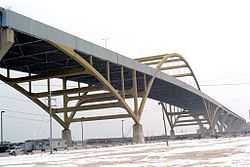Hoan Bridge
| Hoan Bridge | |
|---|---|
 The Hoan Bridge | |
| Official name | Daniel Hoan Memorial Bridge |
| Carries |
6 lanes of |
| Crosses | Milwaukee River |
| Locale | Milwaukee, Wisconsin, U.S. |
| Maintained by | Wisconsin Department of Transportation (WisDOT) |
| Design | Tied arch bridge |
| Total length | 3,057.8 m (1.9 mi)[1] |
| Width | 15.8 m (51.8 ft)[2] |
| Clearance below | 36.6 m (120.1 ft)[2] |
| Construction begin | 1970 |
| Opened | 1977 |
| Daily traffic | 19230[2] |
| Coordinates | 43°01′30″N 87°53′56″W / 43.02500°N 87.89889°WCoordinates: 43°01′30″N 87°53′56″W / 43.02500°N 87.89889°W |

The Daniel Hoan Memorial Bridge is a tied arch bridge that connects Interstate 794 in downtown Milwaukee, Wisconsin, to the Lake Freeway across the Milwaukee River inlet. Originally called the Harbor Bridge, it was renamed after Daniel Hoan, a Socialist, and one of the longest serving mayors of Milwaukee.
It was designed by the firm Howard, Needles, Tammen & Bergendoff and in 1975 won the American Institute of Steel Construction (AISC) Long Span Bridge Award. Although construction on the bridge lasted briefly from 1970 until 1972, it did not open to traffic until 1977 due to public backlash against the planned Milwaukee County freeway system. This halted completion of the connecting roadways and led to the Hoan Bridge being known as "The Bridge to Nowhere."
Its unfinished state was used as the site of the car chase scene in the movie The Blues Brothers. Eventually, the bridge connections were completed in 1998, when the Lake Parkway (Wisconsin Highway 794) opened between the bridge's southernmost exit, connecting the bridge between the Bay View neighborhood and downtown Milwaukee's southeastern tip.
The Hoan Bridge was temporarily closed on December 13, 2000, after two of the three support beams of the lakefront span failed, causing the north-bound lanes to buckle and sag by several feet and leaving the span in a near collapsed state. No motorists were injured when the bridge failed. On December 28, 2000, engineers used explosives to remove the damaged section. The damaged span was restricted to one lane in each direction for eight months while it was reconstructed, and the remainder of the bridge underwent extensive rehabilitation and retrofitting. Two lanes in each direction were reintroduced on October 10, 2001, and the bridge was fully reopened the following month.[3] According to the Milwaukee Journal-Sentinel, at the time of its failure, the six lanes of the bridge had carried an average of only 36,590 cars per day.[4] A total of $16 million was spent to demolish and replace the damaged section and retrofit the remainder of the bridge.[5] Experts believe that improperly designed welds between the lower lateral bracing and floorbeams along with a period of extreme cold and snow led to the partial collapse of the Hoan Bridge.[6]
A complete rehabilitation of the bridge has been approved with construction to begin in late 2013.
References
- ↑ "Daniel Webster Hoan Bridge". Lichtenstein Consulting Engineers. Archived from the original on 2007-03-11. Retrieved 2008-08-11.
- ↑ 2.0 2.1 2.2 "Nationalbridges.com National Bridge Inventory Bridges". NationalBridges.com. Retrieved 2007-10-05.
- ↑ Tom Held (October 10, 2001), Drivers' patience pays off as most lanes reopen on Hoan Bridge, Milwaukee Journal Sentinel, retrieved 2008-10-12
- ↑ Larry Sandler (May 28, 2001), A bridge too far? Drivers avoid the Hoan, Milwaukee Journal Sentinel, retrieved 2008-03-22
- ↑ Larry Sandler (August 2, 2007), Hoan Bridge failure was wake-up call here, Milwaukee Journal Sentinel, retrieved 2008-03-22
- ↑ Hoan Bridge Failure Investigation and Retrofit; A Summary, Lichtenstein Consulting Engineers, archived from the original on 2003-03-11, retrieved 2008-08-11
External links
- Wisconsin Highways
- Failure Analysis (archived version)
- Milwaukee Harbor Bridge at Structurae